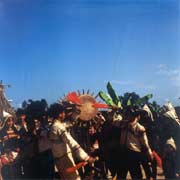| Holy Wooden Drum
 Every December in lunar calendar, flowers in Jino mountain bloom luxuriantly and the time of celebrating the harvest comes. "Dong-Dong-Dong", Zhuoba, an old man of the village, starts to beat the ox hide drum. Once hearing these sounds, the villagers throng into Zhuoba's house, laughing all the way, and, in pace with the meters of drumbeats, have unconstrained dances around the huge drum. This is Jino's traditional folk dance-"Sun Drum Dance". Every December in lunar calendar, flowers in Jino mountain bloom luxuriantly and the time of celebrating the harvest comes. "Dong-Dong-Dong", Zhuoba, an old man of the village, starts to beat the ox hide drum. Once hearing these sounds, the villagers throng into Zhuoba's house, laughing all the way, and, in pace with the meters of drumbeats, have unconstrained dances around the huge drum. This is Jino's traditional folk dance-"Sun Drum Dance".
The wooden drum is the most sacred sacrificial implement and instrument for the Jinos. Generally, every village has a couple of sun drums-the bigger Father Drum and the smaller Mother Drum. The main body of the drum, made of a solid round wood that is not easy to rend, is in the shape of a cylinder, with a length of about one meter and the diameter of 50-70 centimeters. Both two sides are covered with ox hide, nailed tightly with square wooden nails. Below both surfaces are 20 wooden handles separately around the drum. At the points 10 centimeters away from both surfaces are drilled two separate square holes, for the purpose of fastening the rope or passing sticks to carry the drum. The wooden drum is not kept on a shelf, but hung on ropes.
The Jinos regard the wooden drum as the embodiment of divinities and the symbol of the village, and believe that it can bless and protect the whole village to have a flourishing population and an abundant harvest. In normal times, the drums are laid in the houses of Zhuoba and Zhuosheng (another elder whose position is just below Zhuoba), and no one is allowed to touch or beat them. Only when Zhuoba announces the New Year and people have Sun Drum Dances, or in some certain circumstances, the drums are allowed to be used.
Making the wooden drum is an extremely important activity for every village and has a set of strict procedures. The first thing is to select one tree and choose a propitious day to sacrifice chicken to gods and to cut the tree. Cutting trees should be carried out at night, which cannot be seen by women or animals. Prepared drum body should be placed in the particular thatched shack in the village and be covered with the surfaces at the very moment of day-breaking, for the Jinos believe that at this time the moon is falling down, the stars are sparse, and the ground is gloomy without light, so that the shadows of the people covering the drum will not fall into the drum. Before covering the drum, villagers kill chickens to offer sacrifices to the drum. When the covering is finished, the ceremony of sacrifice will be repeated again, and people dance Sun Drum Dance happily. After that, people carry the wooden drum to Zhuoba or Zhuosheng's house to be consecrated, singing and dancing all the way with great rejoicing.
Why do the Jinos have such a great respect for the wooden drum? According to legend, once in the remote antiquity, heaven fell, the earth cracked, and fierce floods dashed to the sky. In the whole world, only the brother Mahei and his sister Maniu hade into the base drum covered with ox hide, following the direction of the Creator, and escaped death at last. In order to reproduce the human beings, the brother and the sister had to get married and bear sons and daughters, becoming the ancestors of the Jinos. They felt deeply indebted to the kindness of the wooden drum for saving their lives, so they beat the drum when celebrating the harvest in every December. When their descendents heard the sounds, they came around the drum one after another and danced for joy to their hearts' content. As a result, the wooden drum and the Sun Drum Dance are handed down from generation to generation.
Consecutive Naming System between Father and Children <<
A People Holding the Maternal Uncle in High Esteem >>
|